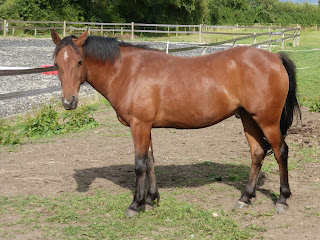Apparently it is going to be really hot here this week, which is not so great if you have horses. I know we wait for the good weather but the boys don't enjoy it much. Basil and Tommy's ancestors are probably from hot countries so in some ways they are better adapted, thin coats, light bones etcetera. Chesney, however, struggles, he is designed for much more moderate weather being big boned and more hairy. They all hate the horse flies though and they are worse this year than I can remember for a while.
So with this all in mind there are a few things to remember for the week ahead:
·
Water and an unlimited supply of it is the most important thing
to remember. An average size horse, in work, can consume over 25 gallons of
water per day when the temperature is above 70°F. So make sure that you keep your
water troughs and buckets clean and free from insects to encourage your horse
to drink.
·
If you usually keep your horse in the stable at night and
out by day in the winter it is a good idea to swap this for the summer months.
This will mean they are not out with the worst of the flies and will avoid the
hottest part of the day. It will also give them time to rest during the day and
cool down at night if we have a prolonged hot spell. An added advantage is that
the time inside will help control their weight, however, they should still have
some forage eg: hay to keep them occupied and their digestive system working.
·
Keep the windows open to ensure a through breeze.
·
If possible spray your horse’s stable walls and/or field
shelter with an insecticide to reduce the number of flies.
·
If your horse is grass kept all year and you do not have
access to a stable, ensure there is a shady place for them to rest. Trees
provide fantastic shade but a field shelter will also provide respite from the
flies.
·
Remove droppings from your paddock regularly and keep the
muck heap a good distance away from your horse’s stable to help reduce fly
problems.
·
Use a fly sheet if possible, fly repellent and fly fringes
are also useful.
·
If your horse is bitten you can treat a one-off bite, with
an ice pack or bathe with cool, salt water (use a teaspoon of salt to two mugs
of water). If your horse has multiple bites, using a mild horse shampoo may
help to remove scurf or bacteria which can irritate the area and will cool the
inflamed skin.
·
White areas on the face and heels can become sunburnt
because they have less skin pigment and hair coverage, so if your horse has to
be in the field in the heat of the day, remember to apply sun cream to these
areas. Human sun cream with a high factor is usually appropriate but if your
horse tends to be sensitive then a more natural cream may be the answer.
·
Sweet itch is a miserable disease for those horses that
suffer. Midges are more prevalent in wet areas close to lakes and streams, so if
possible avoid these areas, have a look at my blog for more
information.
·
If your horse is still particularly hairy in the summer it
may be worth considering clipping. Keeping their manes short will also help to
keep your horse cool.
·
Sponge cold water over your horse, or if he will tolerate it
use a hose, especially down the large blood vessels under the belly and neck
and inside the legs. This will help lower the temperature relatively quickly.
·
Wet weather following a long dry spell can result in a flush
of new grass growth similar to spring, so you may need to limit your horse’s
grazing if you are concerned about laminitis or weight gain. Check out my blogs on Obesity & Laminitis. I have to be careful with Tommy and try to balance time out with the others with being fenced into a sparse area!
·
If you’re competing, leave as early as possible to avoid
travelling in the heat. Keep windows open to keep fresh air flowing through the
horsebox. When you arrive think about whether your horse would be cooler
standing in the lorry or trailer out of direct sun or better outside in the
shade.
Extreme heat can take its toll on a horse working or standing in a stuffy stable or trailer. Heatstroke occurs when a horse is unable to get rid of excess heat from his body. The horses’ natural cooling process will include moving blood flow closer to the skin but this will also mean less oxygen getting to internal organs and the brain. When a horse is also sweating excessively heat stroke can follow. Heatstroke is a serious condition. Severe cases of heatstroke lead to collapse, seizures, or death.
Signs:
- Elevated respiratory rate – if breathing becomes shallow and remains elevated after a few minutes rest
- Elevated heart rate- that again remains elevated after a few minutes rest
- Elevated temperature – 103° or higher
- Sweating – if your horse is sweating all over or stops sweating entirely
- Lethargy – depression, disinterest in food, stumbling or collapsing
- stop work immediately
- allow him to rest in a cool stable or under a shady tree
- poor cool water over his back
- offer small amounts of water every few minutes
- if symptoms persist contact your vet.
Have you seen June's video on my You Tube channel? Horse Life and Love?
Please check it out and SUBSCRIBE.
You can also follow me on Facebook, Instagram and Twitter for updates on Chesney, Basil, Tommy and Daisy.
Until
next time!
Jo







